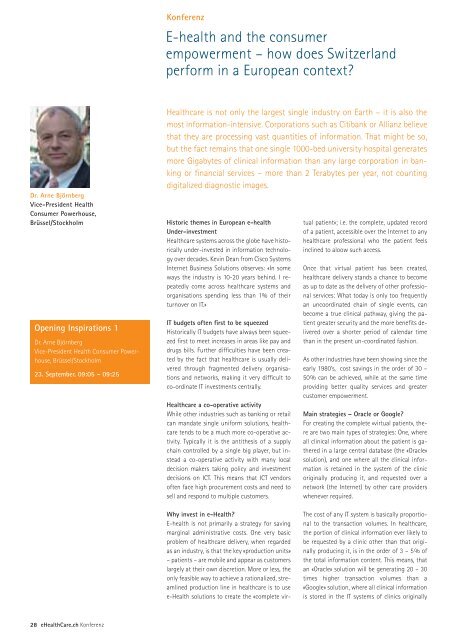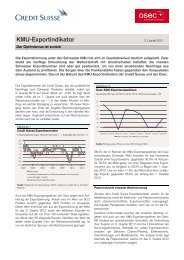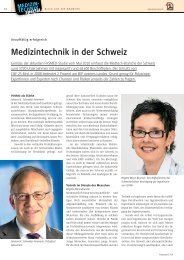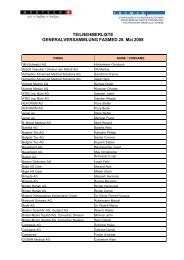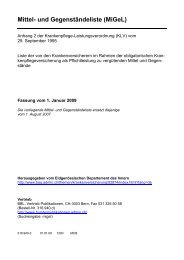JETZT KENNEN LERNEN! Mail: abo@e-health-com.eu - Fasmed
JETZT KENNEN LERNEN! Mail: abo@e-health-com.eu - Fasmed
JETZT KENNEN LERNEN! Mail: abo@e-health-com.eu - Fasmed
Sie wollen auch ein ePaper? Erhöhen Sie die Reichweite Ihrer Titel.
YUMPU macht aus Druck-PDFs automatisch weboptimierte ePaper, die Google liebt.
Dr. Arne Björnberg<br />
Vice-President Health<br />
Consumer Powerhouse,<br />
Brüssel/Stockholm<br />
Opening Inspirations 1<br />
Dr. Arne Björnberg<br />
Vice-President Health Consumer Powerhouse,<br />
Brüssel/Stockholm<br />
23. September, 09:05 – 09:25<br />
28 eHealthCare.ch Konferenz<br />
Konferenz<br />
E-<strong>health</strong> and the consumer<br />
empowerment – how does Switzerland<br />
perform in a European context?<br />
Healthcare is not only the largest single industry on Earth – it is also the<br />
most information-intensive. Corporations such as Citibank or Allianz believe<br />
that they are processing vast quantities of information. That might be so,<br />
but the fact remains that one single 1000-bed university hospital generates<br />
more Gigabytes of clinical information than any large corporation in banking<br />
or fi nancial services – more than 2 Terabytes per year, not counting<br />
digitalized diagnostic images.<br />
Historic themes in European e-<strong>health</strong><br />
Under-investment<br />
Healthcare systems across the globe have historically<br />
under-invested in information technology<br />
over decades. Kevin Dean from Cisco Systems<br />
Internet Business Solutions observes: «In some<br />
ways the industry is 10-20 years behind. I repeatedly<br />
<strong>com</strong>e across <strong>health</strong>care systems and<br />
organisations spending less than 1% of their<br />
turnover on IT.»<br />
IT budgets often fi rst to be squeezed<br />
Historically IT budgets have always been squeezed<br />
fi rst to meet increases in areas like pay and<br />
drugs bills. Further diffi culties have been created<br />
by the fact that <strong>health</strong>care is usually delivered<br />
through fragmented delivery organisations<br />
and networks, making it very diffi cult to<br />
co-ordinate IT investments centrally.<br />
Healthcare a co-operative activity<br />
While other industries such as banking or retail<br />
can mandate single uniform solutions, <strong>health</strong>care<br />
tends to be a much more co-operative activity.<br />
Typically it is the antithesis of a supply<br />
chain controlled by a single big player, but instead<br />
a co-operative activity with many local<br />
decision makers taking policy and investment<br />
decisions on ICT. This means that ICT vendors<br />
often face high procurement costs and need to<br />
sell and respond to multiple customers.<br />
Why invest in e-Health?<br />
E-<strong>health</strong> is not primarily a strategy for saving<br />
marginal administrative costs. One very basic<br />
problem of <strong>health</strong>care delivery, when regarded<br />
as an industry, is that the key «production units»<br />
– patients – are mobile and appear as customers<br />
largely at their own discretion. More or less, the<br />
only feasible way to achieve a rationalized, streamlined<br />
production line in <strong>health</strong>care is to use<br />
e-Health solutions to create the «<strong>com</strong>plete vir-<br />
tual patient»; i.e. the <strong>com</strong>plete, updated record<br />
of a patient, accessible over the Internet to any<br />
<strong>health</strong>care professional who the patient feels<br />
inclined to aloow such access.<br />
Once that virtual patient has been created,<br />
<strong>health</strong>care delivery stands a chance to be<strong>com</strong>e<br />
as up to date as the delivery of other professional<br />
services: What today is only too frequently<br />
an uncoordinated chain of single events, can<br />
be<strong>com</strong>e a true clinical pathway, giving the patient<br />
greater security and the more benefi ts delivered<br />
over a shorter period of calendar time<br />
than in the present un-coordinated fashion.<br />
As other industries have been showing since the<br />
early 1980’s, cost savings in the order of 30 –<br />
50% can be achieved, while at the same time<br />
providing better quality services and greater<br />
cus tomer empowerment.<br />
Main strategies – Oracle or Google?<br />
For creating the <strong>com</strong>plete «virtual patient», there<br />
are two main types of strategies: One, where<br />
all clinical information about the patient is gathered<br />
in a large central database (the «Oracle»<br />
solution), and one where all the clinical information<br />
is retained in the system of the clinic<br />
originally producing it, and requested over a<br />
network (the Internet) by other care providers<br />
whenever required.<br />
The cost of any IT system is basically proportional<br />
to the transaction volumes. In <strong>health</strong>care,<br />
the portion of clinical information ever likely to<br />
be requested by a clinic other than that originally<br />
producing it, is in the order of 3 – 5% of<br />
the total information content. This means, that<br />
an «Oracle» solution will be generating 20 – 30<br />
times higher transaction volumes than a<br />
«Google» solution, where all clinical information<br />
is stored in the IT systems of clinics originally


